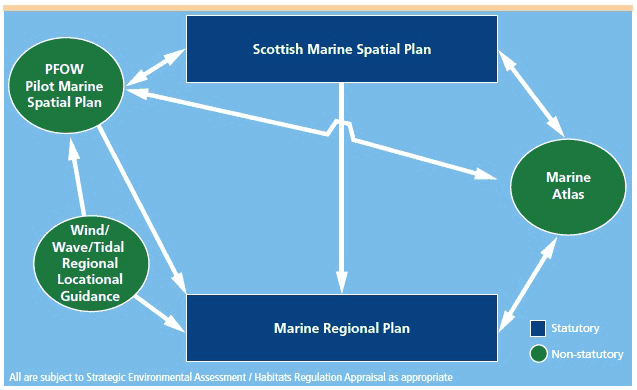Pilot Pentland Firth and Orkney Waters Marine Spatial Plan. The Plan Scheme 2012.
The Plan Scheme sets out step by step how the pilot plan will be prepared and outlines the opportunities for stakeholders to get involved. The Plan Scheme is updated and publicised at key stages in the process to inform stakeholders and the general public
SECTION 3 BACKGROUND TO MARINE PLANNING
INTRODUCTION

Links Between Statutory And Non-Statutory Marine Planning Processes
Marine (Scotland) Act 2010 ("the Act") provides Scottish Ministers with the powers to introduce statutory marine planning for Scotland's seas. The Act creates a new legislative and management framework for the marine environment to manage the competing demands of the use of the sea whilst ensuring protection of the marine environment.
The Act sets out a simplified marine licensing process that will cover nearly all anticipated activities in the marine environment with the exception of aquaculture within 3 nautical miles, which is consented by local authorities. Public authorities have to take authorisation decisions in accordance with marine plans, as defined in the Act, unless relevant considerations indicate otherwise.
Scotland's National Marine Plan sets out the Scottish Government's policies and priorities for sustainable development of Scotland's seas.
A pre-consultation draft of the National Marine Plan was prepared by the Scottish Government in 2011. Further consultation on the Plan will be carried out towards the end of 2013. The Plan promotes the sustainable management of the marine environment, encouraging economic development of marine industries and incorporating environmental protection into marine decision making. National marine planning policies will be provided within the Plan.
Regional marine plans will set out the policies and priorities for sustainable development at the regional level. A consultation on the boundaries of future statutory regional plans was undertaken in 2011 and work is ongoing to enable these to be defined and finalised in secondary legislation.
Sectoral Marine Plans provide a framework for the sustainable development of commercial scale offshore renewable energy developments in Scotland's marine environment, extending to 200 nautical miles from shore. They explore how offshore wind, wave and tidal energy can contribute to meeting Scotland's target of generating the equivalent of 100% of energy demand from renewable sources. The Plans also seek to maximise the contribution of these technologies in achieving a low carbon economy.
Regional Locational Guidance ( RLG) for offshore renewable energy is currently being developed and will sit within the wider marine planning structure being developed by Marine Scotland. This guidance will contain information in relation to the options for future offshore wind, wave and tidal energy emerging from the Sectoral Marine Planning process. The guidance will contain relevant information including, for example, information on environmental sensitivities, other marine users and the socio-economic structure of the area / region.
The work on this current Pilot Marine Spatial Plan (See Section 4) will be closely linked to the work on Regional Locational Guidance for offshore renewable energy during the development of the plan. The 2009 Regional Locational Guidance which contains information on the Pentland Firth and Orkney Waters will also be updated to accompany the Pilot Marine Spatial Plan.
Strategic Environmental Assessment ( SEA) provides a means of assessing the impact that a public plan, programme or strategy is likely to have on the environment. SEA provides an opportunity for public participation in the plan decision making process. A SEA of the pilot Pentland Firth and Orkney Waters Marine Spatial Plan will be undertaken and the findings of the assessment will inform the development of the plan and be documented in an Environmental Report. A public consultation on the Marine Spatial Plan and the Environmental Report has to be carried out before the plan is adopted.
Habitat Regulations Appraisal ( HRA) is a process designed to meet the requirements of the Conservation (Natural Habitats, & c.) Regulations 1994 that requires certain plans which are likely to have a significant effect on a 'Natura 2000' site must be subject to an "Appropriate Assessment" by the plan-making authority. HRA includes determining whether an appropriate assessment is required, together with the appropriate assessment itself where necessary. Natura 2000 is the Europe-wide network of protected sites developed under the European Commission Habitats Directive (Directive 92/43/EEC) and the Birds Directive (79/409/EEC).
The Pilot Plan: Marine spatial planning at a regional level is being piloted in the Pentland Firth and Orkney Waters. This non statutory pilot plan covers from Mean High Water Springs to a seaward boundary of 12 nautical miles. This area has been chosen to pilot the marine spatial planning process because of its tidal and wave resources, which have recently led to The Crown Estate entering into agreements for lease for wave and tidal projects in this area. The pilot plan will aim to guide future decisions made on the proposed offshore renewable energy activities, and other developments in the marine area, minimise potential impacts on other users of the sea, and coordinate marine development with proposed onshore activities.
This non-statutory pilot will not perform the function of a regional marine plan as defined with the Marine (Scotland) Act 2010. If the pilot plan is approved by the Scottish Ministers it will become a material consideration in the determination of marine licensing applications. Consideration will also be given to the pilot by the Scottish Ministers when they make relevant decisions even if it is not subsequently approved by them. There is potential for Highland Council and Orkney Islands Council to adopt the pilot plan as Supplementary Planning Guidance or as Supplementary Guidance to the appropriate Local Development Plan.
Contact
There is a problem
Thanks for your feedback